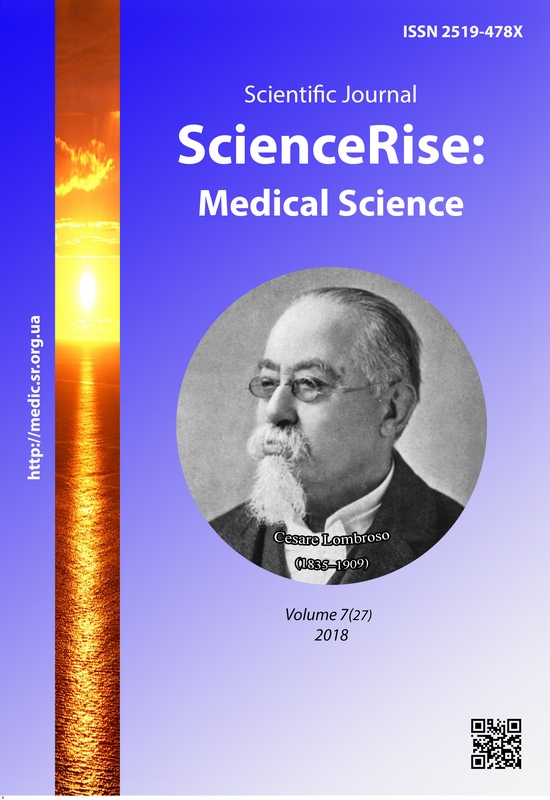Сучасна система психопрофілактики аутоагресивної поведінки у хворих на біполярний афективний розлад
DOI:
https://doi.org/10.15587/2519-4798.2018.149241Ключові слова:
біполярний афективний розлад, депресивний епізод, маніакальний епізод, мішаний епізод, механізми суїцидоґенезу, фрустрація, програма психопрофілактикиАнотація
Мета роботи: Розробити патогенетично обґрунтовану систему психопрофілактики аутоагресивної поведінки у хворих на біполярний афективний розлад (БАР) на основі вивчення особливостей ії формування.
Матеріал та методи дослідження: Для вирішення поставленої мети з дотриманням принципів біоетики і деонтології було проведено комплексне клініко-психопатологічне та психодіагностичне обстеження 117 пацієнтів з БАР з ознаками аутоагресивної поведінки, обох статей, у середньому віці 40,5±5,5 років.
Методи дослідження: клініко-психопатологічний, психодіагностичний, статистичний.
Результати У ході роботи встановлено що у 48,7±2,4 % обстежених реєструвався афективний варіант аут агресивної поведінки, у 31,5±1,9 % – істинній, а в 19,8±1,1 % – демонстративний варіант та описані особливості залежно від полярності афекту.
Аутоагресивна поведінка при маніакальному епізоді БАР асоціювалася з переважанням гнівливої манії у поєднанні з високим рівнем фрустрації в сфері активного життя та незалежності вчинків, високим рівнем інтернальності в галузі досягнень та низьким в галузі невдач
При депресивному епізоді БАР - переважанням тужливої депресії у поєднанні з високим рівнем фрустрації в сфері любовних та родинних стосунках, високим рівнем інтернальності у сфері родинних стосунків та невдач
При змішаному епізоді БАР – поєднанням гнівливої манії та тривожної депресії у поєднанні з вираженим ступенем фрустрації в матеріально-побутовій сфері, високим рівнем інтернальності в сфері невдач та низького рівня інтернальності в сфері результатівності.
Розроблена патогенетично обґрунтована система профілактики аутоагресивної поведінки у хворих на БАР, яка складається з п’яти етапів: кризової терапії, розгорнутої діагностики, основних та підтримуючих лікувально-профілактичних заходів, соціально-психологічної допомоги. Та включає використання методів фармакотерапії, психотерапії та психосоціальної терапії.
Висновки.
1. Аутоагресивна поведінка при маніакальному епізоді БАР асоціюється з гнівливою манією, при депресивному епізоді з - тужливою депресією, при змішаному епізоді з поєднанням гнівливої манії та тривожної депресії.
2. Патогенетично обґрунтована система профілактики суїцидальної поведінки у хворих на БАР повинна складається з п’яти етапів: кризової терапії, розгорнутої діагностики, основних та підтримуючих лікувально-профілактичних заходів, соціально-психологічної допомоги, з використанням на всіх етапах фармакотерапії, психотерапії та психосоціальної допомоги
Посилання
- Takhtashova, D. R. (2014). Program for a dif erentiated prevention of a suicidal behavior in patients with bipolar af ective disorders. Ukrains'kyi visnyk psykhonevrolohii, 22 (1 (78)), 91–96.
- Kapczinski, N. S., Narvaez, J. C., Magalhaes, P. V., Bucker, J., Peuker, A. C., Loredo, A. C. et. al. (2016). Cognition and functioning in bipolar depression. Revista Brasileira de Psiquiatria, 38 (3), 201–206. doi: http://doi.org/10.1590/1516-4446-2014-1558
- Kozhyna, H. M., Korostii, V. I., Zelenska, K. O. (2014). Mekhanizmy formuvannia ta shliakhy profilaktyky suitsydalnoi povedinki u khvorykh na depresyvni rozlady. Kharkiv: KhNMU, 76.
- Maruta, N. O., Verbenko, G. M. (2016). Cognitive impairments in patients with bipolar affective disorder (clinical features, diagnosis, therapy). Ukrains'kyi visnyk psykhonevrolohii, 24 (3 (88)), 5–10.
- Vieta, E., Langosch, J. M., Figueira, M. L., Souery, D., Blasco-Colmenares, E., Medina, E. et. al. (2013). Clinical management and burden of bipolar disorder: results from a multinational longitudinal study (WAVE-bd). The International Journal of Neuropsychopharmacology, 16 (8), 1719–1732. doi: http://doi.org/10.1017/s1461145713000278
- Maruta, N. O., Verbenko, G. M. (2014). Features of clinical symptoms at diff erent stages of the fl ow of bipolar aff ective disorder. Ukrains'kyi visnyk psykhonevrolohii, 22 (3 (80)), 77–82.
- Chaban, O. S., Khustova, E. A. (2011). Bipolar Depression: Problems of Diagnosis and Therapy. NeuroNews, 5 (32), 18–22.
- Kozhina, A. М., Gaychuk, L. М. (2009). Modern strategies in the bipolar affective disorder treatment. Mental health, 3-4 (24-25), 60–62.
- Ocheretyanaya, N. (2011). Bipolar disorder: clinical review. Health of Ukraine, 4 (19), 36–37.
- Trotta, A., Murray, R. M., MacCabe, J. H. (2014). Do premorbid and post-onset cognitive functioning differ between schizophrenia and bipolar disorder? A systematic review and meta-analysis. Psychological Medicine, 45 (2), 381–394. doi: http://doi.org/10.1017/s0033291714001512
- Cole, A. J., Scott, J., Ferrier, I. N., Eccleston, D. (1993). Patterns of treatment resistance in bipolar affective disorder. Acta Psychiatrica Scandinavica, 88 (2), 121–123. doi: http://doi.org/10.1111/j.1600-0447.1993.tb03424.x
- Haustava, E. A., Bezcheyko, V. G., Romaniv, A. P. (2012). Modern aspects of bipolar depression diagnosis and treatment. Neuro News, 1 (36), 38–42.
- Kozhina, A. M., Rezunenko, O. Yu. (2017). Sovremennyye strategii v reabilitatsii patsiyentov s bipolyarnym affektivnym rasstroystvom. Psikhiatriya. psikhoterapiya i klinicheskaya psikhologiya, 8 (1), 78–83.
##submission.downloads##
Опубліковано
Як цитувати
Номер
Розділ
Ліцензія
Авторське право (c) 2018 Hanna Kozhyna, Dina Takhtashova, Galina Koltsova

Ця робота ліцензується відповідно до Creative Commons Attribution 4.0 International License.
Наше видання використовує положення про авторські права Creative Commons CC BY для журналів відкритого доступу.
Автори, які публікуються у цьому журналі, погоджуються з наступними умовами:
1. Автори залишають за собою право на авторство своєї роботи та передають журналу право першої публікації цієї роботи на умовах ліцензії Creative Commons CC BY, котра дозволяє іншим особам вільно розповсюджувати опубліковану роботу з обов'язковим посиланням на авторів оригінальної роботи та першу публікацію роботи у цьому журналі.
2. Автори мають право укладати самостійні додаткові угоди щодо неексклюзивного розповсюдження роботи у тому вигляді, в якому вона була опублікована цим журналом (наприклад, розміщувати роботу в електронному сховищі установи або публікувати у складі монографії), за умови збереження посилання на першу публікацію роботи у цьому журналі.










